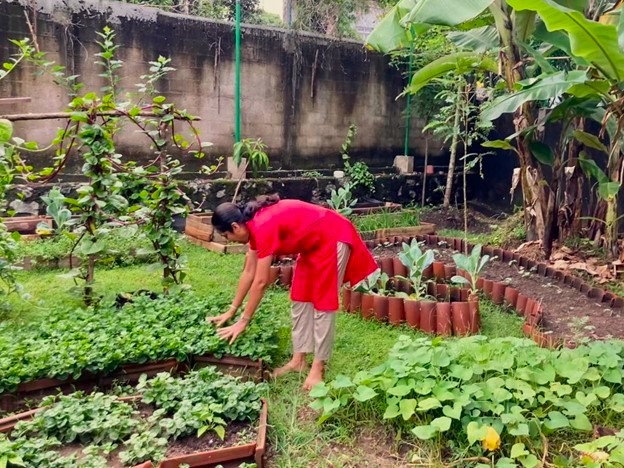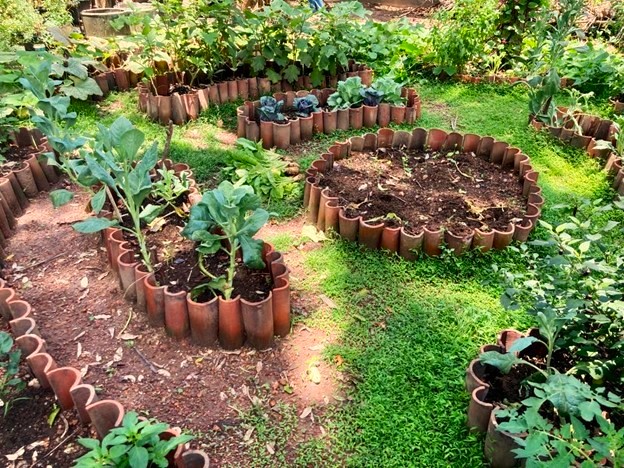by Sarah Clay
On a hot day in late August 2023, I take a tuk-tuk from my hotel and make my way to the outskirts of Colombo, Sri Lanka. My driver skeptically asks me if there is some sort of tourist attraction out there, and when we arrive, he waits in the vehicle until I assure him he brought me to the right place. I am here to meet Kanchana Weerakoon and to visit one of her Metta Gardens. The Metta Garden project is part of the Eco Temple Community, a network of Buddhist priests and other civil society groups all over Asia that originates in Japan and engages in environmental activities based upon beliefs of faith.

Copyright © Sarah Clay 2023
The Eco Temple Community was founded in 2015 in the context of the Interfaith Climate and Ecology Network (ICE) of the International Network of Engaged Buddhists (INEB). Key figures in shaping the project are Jonathan Watts, associate professor of Buddhist studies at Keio University in Japan, and Rev. Hidehito Okochi. Rev. Okochi is a priest of Pure Land Buddhism and has been involved with a wide range of social and environmental initiatives both in and outside of Japan. Based upon his view on Japan’s destructive economic activities and the 2011 Fukushima Triple Disaster, he turned his own Juko-in Temple and Kenji-in Temple into so-called Eco Temples. Located in downtown Tokyo, Kenji-in makes use of only natural and chemical-free building materials, while Juko-in uses renewable energy gained via solar panels on the roof of the building. In 2015, he initiated the Eco Temple working group to share insights on resiliency activities from Fukushima and on creating Eco Temples in urban Japan [1].
The first Metta Garden in Colombo started as an urban garden close to the office of Kanchana Weerakoon’s organization ECO Friendly Volunteers (ECO-V) [2]. When she bought the plot in 2013, there was only a lonely palm tree in the middle of garbage piles dumped by neighboring households. She explains that there is a connection between the outer environment and what humans have within. “If there is a dirty corner in nature, then that is also where dirty people live. […] But when it is a beautiful garden, more clean, more pure, […] then that is where the most spiritual nature is. Strong energy comes out and the plants are happy. And this is also where more content people are.” [interview Kanchana Weerakoon 25.8.2023] As Metta is the Buddhist concept of loving-kindness, Kanchana wanted to create a place for urban people to come and remember the cosmic relationship they have with the natural world.

Copyright © Sarah Clay 2023
When you enter the garden that is ca. 12 x 6 meters in size, you first need to step over a small ditch. After, there is a path made of sharp stones yet, when arriving in the garden soft grass-like plants bring relief under your feet. Kanchana explains to me that this is to remind the visitor that life is a struggle, but that relief can be found in the natural world. The garden is made as a mandala with round plant beddings in all four directions. Each bedding and its plants are connected to an element; tomatoes and peppers represent fire, cabbage water, and the hardness of guava represent the earth. Metta Garden is a sensory garden. The plants are chosen to tickle your senses with their colors, structures, smells, sounds, and tastes. 90% has medicinal properties, and visitors are always encouraged to eat a lot of what they see. In the middle of the garden Kanchana planted a cherry tree that she feels represents herself. She explains to me that in Buddhism the middle is the connection point, it is where you can see both sides. As this cherry tree gives fruits the whole year round, there is always enough for both animals and humans, taking away any hierarchies.

Copyright © Sarah Clay 2023
In the days that followed, Kanchana showed me more Metta Gardens that were created in Colombo in the previous years. Some are private gardens, some are publicly owned, but all are designed as a Buddhist mandala and grown without the use of any pesticides. One visit brings us to a home garden in a busy Colombo district of a man who moved to Italy many years ago. He keeps his house as a holiday home and another family lives there to take care of the building in the meantime. Kanchana explains that she created a mandala garden with smaller beddings, so the man can walk through easily and meditate.
Another garden belongs to a newly found center for the empowerment of women. This garden is designed especially as a fruit and vegetable garden, to provide healthy food to pregnant women and children amidst Sri Lanka’s persistent economic crisis. There are various moringa trees, guavas, and banana plants as well as all kinds of nutritious vegetables. A sunflower blooms in the middle of the mandala, representing joy and happiness.

Copyright © Sarah Clay 2023
Kanchana’s Metta Gardens are indeed small spaces of joy and happiness in a highly urbanized environment. What I find so fascinating is that it is never only about the environment; the idea is that by nurturing the outer world, also the inner world gets nourished. Thus, while Metta Gardens are a reaction to the environmental degradation that is so present in Colombo these days, they are equally created to positively contribute to Sri Lanka’s social issues. This challenges the conceptual dichotomy of society and the natural world. Metta Garden also illustrates that projects that are part of the Eco Temple Community are always transnational and local at once. All projects share an understanding of Buddhist concepts and the tasks that religious practitioners have in this world. Although originating in Japan, these forms of knowledge are translated differently in the various sites according to the social and environmental needs that exist on the ground. As such, they provide insights into the ways in which religious traditions gain different meanings and practices according to time and place.
[1] website Eco Temple Community Development Project https://eco-temple.net/
[2] website Eco-Friendly Volunteers https://eco-v.org/metta-garden/
